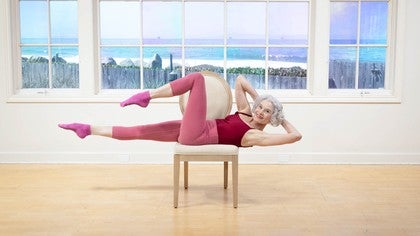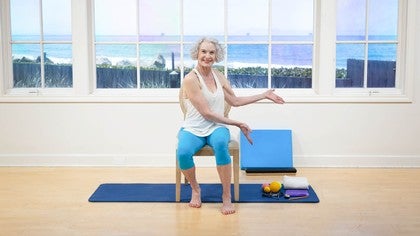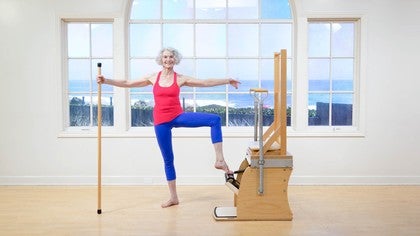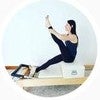Description
Props Needed: Chair, Small Ball, Towel, Theraband, Pencil and Paper
About This Video
Transcript
Read Full Transcript
Hi. I'm Jillian Hessel. And today we're talking feet. When we first came up with the idea for this class, we were focused on the need for the mature client to maintain foot mobility, strength, and stability, but in fact, we all need it. So I've got a little basket of props.
We'll be picking and choosing different exercises that you might wanna introduce for yourself or for your clients if you're a teacher and probably not do everything that I'm doing today in one lesson, but hopefully, you find something that resonates and what you need for yourself or your clients. So I want to talk a little bit about the mobility of the foot, because in old times we didn't have concrete parking lots and sidewalks. We had to be able to adapt to uneven surfaces. So here you see I'm on a stability cushion and my feet are kinda wobbly. Especially if I'm standing on one foot, I really have to work to hold my balance.
So the foot needs to be mobile and adaptable in this case. But we also need the foot to be strong and supportive when we walk. So when we walk, the first thing that happens is we strike striding forward with the heel or the calcaneus. And we roll through to mid-stance where the ball of the foot, both the big toe and the little toe and the heel are supporting. Now, if we have a collapsed arch, we get this kinda rolled in look through the arch.
So that's an issue we work with a lot. We wanna keep that longitudinal arch of the foot strong. And then as I transfer my weight from mid-stance and strike the other heel forward, the back foot has to roll to the toes and push off. So those toes are important for propulsion, heel strike, roll through, toe off, heel strike, roll through, toe off. So this is something as we work barefoot in Pilates that we can really help our clients with.
So I'm going to demo some exercises to work the intrinsic muscles of the feet to begin with. And we'll also be talking about what I like to call the dome of the foot, not just the longitudinal arch but the transverse arch through the metatarsus. So I'm going to take a seat on a chair. And the first thing that I'm gonna do is give my foot a little massage. So this is something that you can do at home with me.
Sit in the front edge of the chair, don't sit back. Take one foot and cross it over. And we're just gonna start by flicking the toes. Yeah, just little flicks right at the tips of the toes. We wanna really kind of wake up the nerve endings, so work back and forth and then grab your toes, I'm starting with the pinky and the fourth toe and just do a little running in place with the toes back and forth, back and forth, change to the middle toe and the fourth toe, running back and forth, back and forth.
And then the second toe and the middle toe, and finally, the second toe and the big toe. And then go back and you're at the fourth toe and the pinky toe and open and close, like a little scissor. Open and close and open and close moving all the way through to the big toe and the second toe. So now you're gonna massage your foot. This is the metatarsus or the roots of the toe.
We wanna kind of really massage. So I've got my two thumbs on the sole of the foot, and I'm just working my way into the metatarsus across the bottom of the foot from the pinky to the fourth, to the middle, to the second, to the first, and then moving behind the metatarsus into that dome of the foot I was talking about, the arch. Work your fingers in there. One of my favorites is to take the heel of one hand and the heel of the other and just kinda work it in there. Okay.
So you're working the top of the foot and the bottom of the foot, kind of like a sandwich action. Come all the way back to the heel and work your way back towards the Achilles tendon and around the ankle. And you can then, hopefully, spread your fingers and thread them through. This can be painful for people who don't have foot mobility. I've threaded my fingers all the way through to the roots of my toes and the roots of my fingers, and I'm gonna take that foot, oh, does that feel good and rotate it around and back.
And then I'm just gonna take the knuckles of my hand and kind of give myself a little bit of tapping, tap the foot all the way around. And then you're gonna unhook that foot and put it down and look at the color of one foot versus the other. The one that I've just massaged is a completely different color. Let's stand up for a moment and just walk around and feel the difference between the foot that we've just energized and woken up and the foot that needs the massage. Okay.
So let's come back, sit down and take your other foot. So we're gonna start just by flicking. And these toes just feel mashed together compared to the other ones that feel so alive, flicking the tops of the toes. And then we're gonna take the pinky toe and the fourth and run in place back and forth, back and forth. This is some of the action that we need to propel ourselves forward with that walking that I just showed.
And I've moved to the fourth and the middle and the middle and the second, running, running, running, and the second and the big toe. And then we're gonna go back to the fourth and fifth toe and scissor open and close, so different action, spreading the toes apart. And moving to the fourth and third and the third and second and the second and the first, right open, close. And now just a little bit of massaging. Right at the toes, there's a lot of bones in the toes.
If you look at the anatomy, our toes are shorter than our fingers, but all the same bones are present and the foot is adapted to propel and support us in a different way than the hands. So now I've moved to the metatarsal now and I'm working what we call the roots of the toes. And now just behind the metatarsal, nice massaging. You can even make a fist and dig in there a little bit, feels really, really good. And moving back to just behind the heel, the back of the arch of the foot, and then all the way to the heel, massaging, make a fist and just do some tapping.
And I forgot to thread the fingers on this side. So let's not forget that. That's a really good massage. So spread those fingers and toes wide. Thread yourself in, see if you can get all the way to the root of the toes and the fingers.
This side is harder for me. I forgot to tell you. I have some strange things on my toes 'cause I was a ballerina. So I don't have the most beautiful feet, but I try to keep them mobile. So I'm giving myself a good massage there.
I'm gonna work the ankle now in both directions. And hopefully, now this foot is waking up. So I'm gonna put it down and take a look. And yes, the color is different. So now I'm gonna get up and walk again.
And the feet both feel much more alive. I'm really aware now of my heel strike, mid-stance, push off. So the feet have woken up. So now we're gonna come back to the chair, and I'm gonna show you I have a variety here of small balls. All right.
So I don't know what you have at home, but I prefer to work with what I call the pinky ball. The tennis ball is a little bit hard and it tends to shoot out and escape away. Here's a little bit of a softer ball. Remember that mature clients may have some thinning of the tissue in the bottom of the feet and some sensitivities. So the pinky ball has some give, this ball is a little bit softer, although it's bigger, and then I have a very small smiley ball.
You might go as small as a golf ball, so it's really up to you. What I wanna show you is working the transverse arch of the foot now, which is this. If I knuckle, make a fist with my foot, there's an arch that should go across the foot. And all those knuckles that show on your fingers should show on your toes. So this exercise could be done standing up as well.
And you can sit on the floor if you're a teacher and partner your client with this, but I'm gonna do it seated so that I can partner myself. So I'm going to place my heel on to the floor and remember that heel strike. So this is very similar, and then I'm really gonna spread my toes apart, really spread them. And what I'm working for here, I'm just gonna turn sideways for a moment, is to get the metatarsal of the big toe joint, this one right here, at the apex of the ball. So think of your ladder barrel or your spine corrector.
You wanna place the hips when you're working with the big apparatus at the apex of the arch. Same thing here. So it's a mini arc. When a really push down, now remember the heel strike, we go through to mid-stance and we wanna push that big toe joint down, down, down, over the ball, and then stretching out the toe, really try to grasp and grasp fully so that that metatarsal joint pushes out. And you can see it's a little bit of a white knuckle.
And then I lift off. So if I'm standing, I'm gonna stay upright as I'm walking and push down on the heel and press down. Now, if you're doing this seated, it's very important. Now I know I'm leaning forward to show you, but it's very important to keep your Pilates idea of good posture. So I'm sitting to the close edge of the front of the chair, and I'm not leaning over.
I wanna use the strength in the intrinsic muscles of the feet to do this press down. And I'm gonna do it three times. So that was two, heel strike, push the ball of the foot into the ball, reach the toes and grip. Now I have very short toes, so there's no way that I'm gonna be able to fully pick up the ball, but that would be the goal at the end. Now I'm gonna move the ball just a little bit under my second toe and work at the same way.
So I push my heel down, imagine a heel strike, reach those toes out, spreading them wide. And here it's really difficult. You can see I have a little bit of a old, stress fracture here, but there's my second metatarsal. You can see the white. Yes, that's what we're going for.
And heel strike, I'm slipping a little bit, press down, stretch and grab. And one more time, three times, heel strike, push down that second metatarsal, spread the toes and grab. So we don't wanna grip so hard that the toes curl. Now, I'm moving into the middle of the foot, third toe joint, same idea. And be careful if you have a client that has a dropped longitudinal arch that they're not collapsing here.
We're really working, not just this transverse arch, but also all of the muscles that lift and dome the arch of the foot. And once again, I think this is the third one and press down. Then we move to the fourth toe, same thing. So if I were partnering this, I might actually help the clients spread the toes, press down that toe joint and stretch the toes long to really make a grip. And you can see my toes are really changing color with the circulation that's coming into the feet.
And then we're gonna move finally to the Mr. Pinky toe, not to be forgotten, press down Mr. Pinky and reach and grab. And sitting up tall, I'll do it nicely and smiling into the camera, but I am pushing really hard with my foot. So then before we change sides, we can do a nice little massage. And this is kind of the same thing. My heel is now lifted.
So I'm moving that ball around. And then the final thing, which I can't demo for you with the pinky ball, unfortunately, would be to really center and try to pick up the ball. Now I might have some more luck with the yellow ball, which is squishy, but my toes are kinda stubby. And it's not so important that you pick the ball up as that you have the action and the intent. I almost picked it up, but my feet are sweating.
There we go. That's what you're going for if you can with the pinky ball. I have seen it with people with longer toes. So also you can of course try with a smaller ball, but my feet are really sweaty now, so I don't think that's gonna happen. And again, it doesn't matter so much whether you pick up the ball as that you have that intent.
So now I'm gonna go back to the other side, and we'll quickly review so that we're even in case you're working out with me. So we can massage a little bit to begin. And then we're gonna go through again the idea of the heel strike. Now on this toe, this foot, you may notice I have a bit of a giant bunion, so that I'll address in a minute. But first, we're just striking the heel, pushing that big toe joint down.
And here, I can guide myself a little bit. I don't want that toe to over cross 'cause that encourages my bunion. I want the toe to migrate back to where it belongs, which is straight down and lift up, press down the heel, the ball of the foot into the dome of the ball, and then reach down. And you can see that toe, it just popped, (laughs) doesn't wanna go straight down, it wants to add duct. So I'm kinda helping him a little bit.
Move to this second toe. Now this one, I have a bit of a deformity here. I went on point too soon and you can see there's a very large lump on that second toe. And I think that's what's caused my bunion actually, but these exercises are so good to keep the mobility and flexibility in the feet. Remember that all of this is important for walking and we wanna maintain all those activities of daily living.
I've moved to my middle toe now. And you can see, although I've got a very prominent second toe metatarsal, that this third one, because of all this deformity in big toe and second toe, this one is kind of collapsed. That's what we call a dropped metatarsal. I know you can see my fourth and fifth and my first and second. Where is Mr. Middle toe?
I need to really work on that because I'm losing a little bit that transverse arch. Okay. Now we go to the fourth one, heel strike. Make sure that the client is tracking the knee correctly as well. I forgot to mention that, but if the inner arch, the longitudinal arch is collapsing, we really can have a problem there.
And now I'm going to sit up tall and do this correctly. (sighing) I sit up tall and I press down and grip, and I'm on my pinky toe and three times and release. And a little massage. And again, remember the intent, if not the action to spread those toes, wide dome the foot and lift the ball, which is not happening on this side for sure. Okay.
So my left foot is a little bit weaker than my right. And you'll find you might be right-handed, left-handed, the same thing can happen in the feet. All right. So we're moving on now from the balls, I'm gonna put those back, to our towel. And this is what I like to call the inchworm.
Yes. So you can do this seated or standing. I'll do it standing. I'm gonna mimic my heel strike, place the toes, spread them down. And I'm gonna grab just like I was trying to grab that ball and pull the towel and lift up and spread the toes and pull the towel.
So this is one that you can do after your shower or with a hand towel, grabbing and pulling. So that's a very useful one. And you can also have, if you have kids and you want to have fun, inchworm toe walk races. So I'll just demo that without the towel. It's a little bit easier in socks, especially if you've got thinning soles of the feet, but it would essentially be the same idea, just gripping the toes.
And notice as I pull myself forward, I'm mimicking what we already did with the pinky ball, the transverse arch, which is the grip of the knuckles, as well as the longitudinal arch, which is from toe to heel. So this is strengthening that whole doming action of the foot. And we can go fast. Yes, have little races and relax those toes. Take a walk again, see how that feels.
And you should feel that your toes are much more alive and really able to push off in walking and running. This is very, very important. All right. So now we're moving on to, we would use the toe exerciser if you have one. But if you don't have one, it's very useful to collect rubber bands.
So I'm gonna show you why I love the rubber bands, even though I love the toe exerciser. Again, perched on the edge of the seat, in that heel strike stance, we would take the toe exerciser and put it across the big toes. Now, one of the issues for me, you already saw, I have a bunion, and when I pull apart, it pulls my toe, which is great, into the correct position. And I'm gonna spread the toes, really fan them out, I always say Japanese fan. And then here's the transverse arch of the foot.
I'm going to attempt, just like with the piano, to touch just my toe tips. And here, I've got the knuckles and the transverse arch, as well as the longitudinal arch of the foot. And then I relax. So this works great, but I'm gonna show you now, these are from celery, these little toe bands, toe elastic bands. And the thing that I like about this is I can place one the way I had the toe exerciser, but very good for this migrating toe.
I'm gonna place the second one just at the base of my toenail. So I've actually got two bands, and that's gonna really help me train that bunion toe. So same idea. I'm sitting to the edge of the seat. I'm upright.
I'm not leaning forward. I know I keep leaning forward because I'm teaching myself, but you will heel strike, lift up, spread those toes as wide as you can. So you really wanna pull the pinky toes apart. And you may find that that's very difficult for you, and see if you can play the piano. So we've got pinky toe, fourth toe, third toe, (cheering) second toe, big toe, and relax.
And again, lift up, flex at the ankle, pull apart, spread the toes wide and play the piano. Let's do a couple more. Flex up, pull apart. So start shopping for celery. Checkout where you can buy it where you get these wonderful, short, thick elastic bands and you don't need a toe exerciser unless you already have one.
All right. So we really want both this domed front foot and back foot, and my arches are getting tired so that I know I'm doing something right here. Take off your band or your toe exerciser. And now we're going to move to some really fun exercises with a pencil. So hopefully, you have a number two pencil.
I like this because it's got a kind of angled sides, six side, hexagonal. I think that's the right pronunciation. Grab a piece of paper. And you might want your towel back so that you can wipe the bottoms of your feet. If you're like me, I get sweaty feet.
So this is actually an exercise from Carola Trier. I worked for her for many years, and she has this in her book for children called "Exercise, What It Is and What It Does". So we're going to take the pencil. It's very important that if you're gonna work your right foot, you have the point of the pencil angled out to the pinky toe. And take a look at your foot.
My toes are rather square, which helped me out with point dancing. But if your foot is angled more with longer toes, you're gonna angle the pencil. So you wanna take a look at your metatarsus and angle the pencil carefully so that we are going to, as best we can, I'm gonna move to the edge of my chair again, right up on the sit bones. And you could do this standing as well. I'm just doing it seated because I'm helping myself.
So I'm on that heel strike again that we've discussed, and I'm gonna spread the toes as I did with the toe exerciser. And I'm gonna reach over the top of the pencil. And once again, pinky, fourth, third, second, first, and I've got to angle my pencil a little bit better. I wanna get right there and see if I can pick the pencil up. Now, you see I did, but I've dropped it because I only really had it from my pinky toe.
So we got to try that again, and spread and wrap and see if we can really grip the pencil and pick it up. And I did a little better, but it's not really under my big toe. I'll try one more time, and then we'll try the other side. And I'm a little bit cheating there. So I'm gonna help myself by shoving the pencil under and grabbing.
So now I've got a really good grip. You can see all five of my metatarsals even though I have some deformities from my point dancing. And I'm gonna take the piece of paper and see if I can write something. Usually Carola would have us write our name. So I'm gonna start and hold the paper with the other toe, and see if I can print, J-I-L-L.
Oops, there it is. I-A and N. So that's kind of a fun thing. And then we'll try the other side. So here's my name.
Looks like I'm just learning to write. Yes. (laughs) Okay. So let's try the other foot. So I'm gonna move the paper over here.
Maybe I'll flip it over so I have a fresh one. Now this is not my great foot, but we're gonna try as best we can. So once again, I'm positioning my heel in that heel strike position perched right on the edge of my seat, sit bones are down and spread those toes and grab. And you see, I have not so much success on this side, but it's important to try both sides 'cause of course we need both feet for walking. So I'm not greatly successful with my left foot.
But as I mentioned before with picking up the ball, it's important to try. So you can see I'm not as good with my left foot. Not a huge surprise. I'm not even able to begin picking up. There.
That actually isn't bad, but I don't have a good enough grip I know to write with. I'm gonna help myself a little, spread the toes, pack that pencil in there and really take a grip. It's hard for me to hold on this side, hold the paper down and see if you can write with your other side. So there's my writing. Actually, I seem to be able to write better now that I've helped myself grab the pencil.
I think this is quite legible. I'm impressed with myself. So there's my left foot writing. Yes. Good.
All right. I'm very proud of myself. So we're gonna move on now to the mat and work a little bit with elastic stretchy band. So I've got kind of a medium, heavy guy here, but you can work with a lighter one for sure. So I'm gonna just move the chair and come to the mat and take the band.
And I like a little bit of a wider band. This is a Dyna-Band. I know the Thera-Band is a little narrower, but I like the Dyna-Band because it's wide and I can really get the foot fully into the band. So I'm really stepping into the band with my metatarsus. The knee can be slightly bent, and we're just gonna work, reaching through the heel, the ball of foot and stretching the toes without crunching them.
And then peel back just the toes, there's your push off in your walk, the ball of the foot and the heel and heel ball till I know I straightened my knee, but you can do this bent. It's not important to have a hamstring stretch while we're working the feet, but feels good and stretching and pulling back. I'm just gonna do one more and stretch and pull back. So of course, I want a good alignment, hip knee, ankle foot. That will be important when we get on the larger Pilates apparatus, eventually.
Now here's a home position. Be sure that you're not just pulling the big toe or the little toe and winging, but really in a true parallel, reaching through the entire ankle. Now this is our home position. We're gonna rotate around now through the point back out and back to home. So we reach and circle.
I like to breathe with it, inhale, (sighing) all the way through without crunching the toes, exhale and inhale (sighing) and exhale. And of course you can do more reps, and then reverse it four (sighing) and three and two and one. And change feet. And same thing on the other side. Stepping into the band, the knee can be bent or straight, reaching through heel, ball of the foot, stretch the toes without crunching them and peel back, toe ball, heel, reach through, heels, ball of the foot toe, stretch those toes into the band, peel back two more and reach and pull back.
And once again, reach and pull back. Home position. The knee is tracking directly over the center of the feet. It's a good view from the floor and reach around and pull back. (sighing) And pull back.
Keep those toes from cramping and crunching. Mine are wanting to cramp up here. And I think that was three or four. I'm doing four each way. I'm trying and reverse it, inhaling and exhaling.
(sighing) And two and three and four. So that's great stuff for the feet. And now we're going to actually move back to a standing position. And I'm using the chair as a support, but you can use the wall or a window sill or the Cadillac uprights if you have a Cadillac in your studio. So think creatively.
You can also use this with the Wunda chair. So if you have a Wunda chair with handles, you can use the handles on the chair, take all the springs off and just push the pedal down. This is a foot bar made by Deborah Lessen Pilates. It's really lovely. And we both worked at Carola Studio, and she had a bar very similar to this.
If you don't have a bar or anything like that at home, another thing that can work is a stack of a couple of coffee table books. Just make sure you have it sticky so that the coffee table books aren't gonna slip. Yes. And another option, this is a half foam roller. So you have a lot of options to do this exercise.
So I'm going to climb onto the foot bar. And the important thing here, if you have an angled foot, is that you're going to be far enough forward to get not just the big toe joint metatarsal, but what Carola used to call the root of the pinky toe. That fifth metatarsal is very important repositioned on your book or your pedal or your foot bar. So I'm gonna climb up here and I don't have much of an angled foot, so I don't have to be terribly far forward, but I'm going to have my feet right under my hips straight ahead. And I wanna make sure also that I'm not a standing sway back.
So all of the Pilates starts to come into play here. Shoulders have to be over the hips and we're just gonna let the heels hang down. It's a nice stretch. Be sure you're not locking the knees back into hyperextension. Just engage the glutes.
And we're just going to pull an imaginary marionette, string up the crown and rise up on an in breath and lower down with control. We'll do five, rise up, inhale, exhale, lower, watching the tracking. Make sure that your clients with knock knees are lifting those arches. This is four (sighing) and five. And lower the heels down.
Keep the heels reaching down below the level of the foot bar. And by the way, maybe your client can do this without holding on, or maybe just one pink finger. Bend those knees. Watch that the knees are tracking, not rolling in, not rolling out, right over the center of the toes. The heels don't move, we straighten.
Knees track over the toes, inhale, exhale, straight and see if you can do it with just one finger. Bend and straighten, maybe no hands. Bend, that's harder and straighten. Now I'm gonna bend the knees, hold them there. The head is not gonna move.
I'm gonna roll up. Think of that toe off with our walking, pressing up, rolling down. And I'm really engaging the base of the glutes here so that my knees are tracking correctly over the center of the toes. This is three inhale so you have the balance is. Four, rolling up, rolling down.
Ooh, I almost fell. And five, rolling up and rolling down. Now I'm going to lift those heels. And again, we wanna be sure we're not rolling out or rolling in. So if I lift my heels too high, I'm gonna lose that fifth metatarsal.
Keep the weight spread evenly. And from here, we call this a forced arch position, I'm gonna pull an imaginary marionette string and straighten up, sit back down. I'm not flexing forward or back from my shoulders. Right from my hips, I'm going straight up and down. Think of foot work on the reformer.
It's the same idea. Three, (sighing) inhale, exhale, four and one more. Stay up on five. See if you can balance there. Make sure you're not rolling in or out.
And now we lower the heels down with control, and we're going to bend the knees and do a combo. Lift the heels, rise up without rolling in or out and lower down. Bend those knees, lift, rise up, stay tall and lower down with control, three, lift, rise and lower, four, lift. Add your breathing. Don't hold your breath.
One more. Bend those knees, lift. Let me see if I can do that with one finger on the bar. And now I'm reversing it. I rise up, keep the body straight, bend those knees with the heels lifted, roll down through the feet, very important and land.
So for jumping, when we land, this is how we're landing. It's a cushioned landing, and three. (sighing) And you should be feeling this all the way up into the outer glutes and same thing on foot work, either on the chair or the reformer. One more time, (sighing) inhale and roll through and relaxed. So here we can do our running in place, drop one heel, lift up and switch.
So we're doing our foot work. and pressing up. So there's as much work on the foot lifting up as on dropping down. We don't wanna see the pelvis shifting. Yes, very square just like we do on the reformer.
So now this can also be done in Pilates V, little bit trickier if you've got a narrow bar or a angled foot, but we could do the whole thing right. And we could also do single leg either in parallel, very important if someone's sprained their ankle, yes, to work that single, weaker side. We can also do it in Pilates V single leg. And it's really important to feel that connection from the feet all the way up into the hips. So I hope I've given you a lot of ideas of exercises you can do for yourself or for your clients to keep the spring in your step.
And of course, all of this applies when we get on the larger apparatus. So thanks for joining me, and enjoy.
Empowered Aging: Active Baby Boomers
Comments
You need to be a subscriber to post a comment.
Please Log In or Create an Account to start your free trial.














